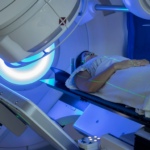
A pituitary tumor is a mass that grows on the pituitary gland, which is located at the base of the brain. These tumors can cause a variety of symptoms depending on their size and location, including hormonal imbalances, headaches, vision problems, and more. Treatment options for pituitary tumors include surgery, medication, and radiation therapy.
Radiation therapy is a non-invasive treatment option that uses high-energy radiation to shrink or destroy tumors. It can be used to treat pituitary tumors that are too large or too close to sensitive structures in the brain to be removed surgically. It can also be used to treat tumors that have come back after surgery or medication.
Several types of radiation therapy can be used to treat pituitary tumors, including conventional external beam radiation therapy, stereotactic radiosurgery, and proton therapy.
Conventional external beam radiation therapy involves using a machine called a linear accelerator to deliver high-energy radiation to the tumor. The treatment is given in small doses over several weeks to minimize side effects. This type of radiation therapy is effective for reducing the size of pituitary tumors and improving symptoms, but it can also cause side effects such as fatigue, nausea, and skin irritation.
Stereotactic radiosurgery is a type of radiation therapy that delivers a high dose of radiation to the tumor in a single session. This type of radiation therapy is very precise, which means it can minimize damage to surrounding healthy tissue. It is typically used for smaller tumors that are located in areas that are difficult to access with conventional external beam radiation therapy.
Proton therapy is a type of radiation therapy that uses proton beams instead of X-rays to deliver radiation to the tumor. This type of radiation therapy is also very precise and can minimize damage to surrounding healthy tissue. It is typically used for tumors that are located near critical structures, such as the optic nerve, that are sensitive to radiation.
While radiation therapy can be effective for treating pituitary tumors, it does have some risks and side effects. Some potential risks include damage to healthy tissue surrounding the tumor, which can lead to neurological symptoms such as headaches or visual disturbances. There is also a small risk of developing a secondary tumor as a result of radiation exposure.
Common side effects of radiation therapy for pituitary tumors include fatigue, nausea, skin irritation, and hair loss. These side effects are typically temporary and can be managed with medication or lifestyle changes. Patients may also experience some hormonal changes as a result of radiation therapy, which can be managed with hormone replacement therapy.
If you are considering radiation therapy for your pituitary tumor, it is important to discuss the risks and benefits with your doctor. They can help you determine if radiation therapy is the right treatment option for you based on your individual needs and the characteristics of your tumor. They can also help you manage any side effects or complications that may arise during or after treatment.
In conclusion, radiation therapy is a valuable treatment option for pituitary tumors that cannot be removed surgically or have come back after surgery or medication. It is effective for reducing the size of tumors and improving symptoms, and it can be delivered in several ways depending on the characteristics of the tumor. However, it does have some risks and side effects that should be discussed with your doctor before starting treatment. With proper monitoring and management, radiation therapy can be a safe and effective way to manage pituitary tumors and improve quality of life.




